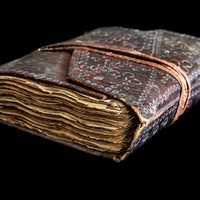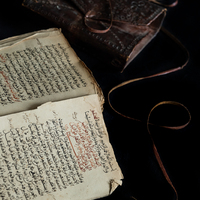Manuscript from West Africa
Item
Title
en
Manuscript from West Africa
cs
Rukopis ze západní Afriky
Date
1100-1200
Description
en
The OI’s acquisition of this manuscript, "Sirāj al-mulūk" by al-Ṭurṭūšī, is notable due to its rarity. al-Ṭurṭūšī is an Andalusi author from the 11th and 12th centuries. This manuscript serves as evidence that this widely known and widely circulated work which found its way to West Africa which is the place of origin for the manuscript in question. The author of the main work is identified as Muḥammad b. al-Walīd b. Muḥammad b. Jalaf b. Sulaymān b. Ayyūb, known as Abū Bakr, Ibn Abī Randaqa, or Abū Bakr al-Ṭurṭūšī. He was a member of the al-Qurašī al-Fihrī al-Ṭurṭūšī al-Mālikī (1059-1126) lineage.The main work itself is titled "Sirāj al-mulūk wa-l-khulafāʾ wa-minhāǧ al-wulāt wa-l-umarāʾ" and is accompanied by three additional folia at the end of the manuscript, which contain excerpts from "Sirāj al-mulūk wa-l-khulafāʾ." The additional texts provide further insights or supplementary information related to the main work. Although it does not contain the place of copying, nor is it clear the name of the copyist, the binding, paper, and handwriting are typical examples of surviving sub-Saharan manuscripts in Arabic script. It is worth noting that Usman Dan Fodio (1754-1817), the founder of the Sokoto Caliphate, which encompassed areas of present-day Cameroon, Burkina Faso, Niger, and Nigeria, draw heavily on Siraj al-Muluk in his work Bayān Wujūb al-Ḥijra ‛alā al-‛Ubbād.
cs
Vzácný rukopis „Sirāj al-mulūk“ od andaluského autora al-Ṭurṭūšīho (11.-12. století). Jeho existence dokládá, že dílo bylo natolik známé a rozšířené, že si našlo cestu až do západní Afriky, kde byl tento rukopis zhotoven. Autor hlavního díla je identifikován jako Muḥammad b. al-Walīd b. Muḥammad b. Jalaf b. Sulaymān b. Ayyūb, známý jako Abū Bakr, Ibn Abī Randaqa nebo Abū Bakr al-Ṭurṭūšī. Pocházel z linie al-Qurašī al-Fihrī al-Ṭurṭūšī al-Mālikī (1059-1126). Celý název hlavního textu zní „Sirāj al-mulūk wa-l-khulafāʾ wa-minhāǧ al-wulāt wa-l-umarāʾ“ a dopňují ho tři folia na konci rukopisu, která obsahují výňatky ze „Sirāj al-mulūk wa-l-khulafāʾ“. Další texty poskytují bližší poznatky nebo doplňující informace k hlavnímu dílu. Ačkoli místo vzniku opisu ani písař, jenž je opsal, nejsou uvedeni, vazba, papír a písmo jsou typickým příkladem dochovaných subsaharských arabsky psaných rukopisů. Za zmínku stojí, že Usman Dan Fodio (1754-1817), zakladatel Sokotského chalífátu, který zahrnoval oblasti dnešního Kamerunu, Burkiny Faso, Nigeru a Nigérie, ve svém díle Bayān Wujūb al-Ḥijra ‛alā al-‛Ubbād ze Siraj al-Muluk poměrně významně čerpal.
Note
The excerpt is taken from the description of Prof. Josef Ženka, Ph.D., Associate Professor at Charles University's Faculty of Arts, Department of Middle Eastern Studies.

